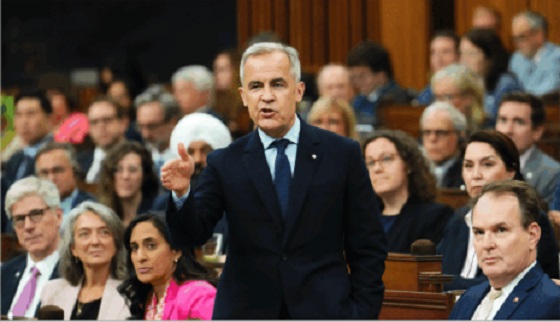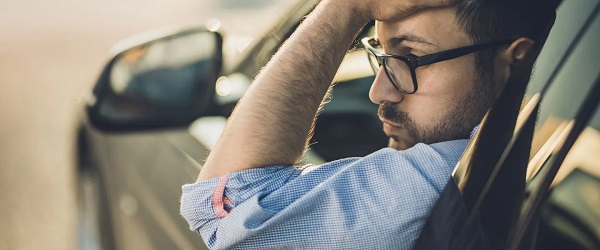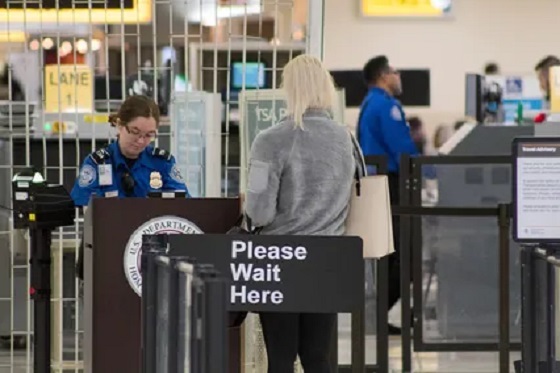Economy
The case against Net Zero 2050

Fossil fuels expert Alex Epstein shares everything you need to know about fossil fuels and what the world would really look like if we were “net zero” by 2050.
—
Alex Epstein is a philosopher and energy expert who argues that “human flourishing” should be the guiding principle of industrial and environmental progress. He is the author of the New York Times bestseller, “The Moral Case for Fossil Fuels,” and his latest book, “Fossil Future.”
For months I have been eagerly anticipating a scheduled debate I had at the University of Syracuse on “net zero by 2050” with climate catastrophist and net-zero advocate Tom Rand.
Unfortunately, due apparently to some sort of weird contractual issue between Tom’s agent and the university, Tom did not make it to the debate.
Since I was supposed to be in a debate, but there was no one to debate, I thought the best I could make of the situation would be to give a speech refuting every single argument for “net zero by 2050” that Tom and others make. It ended up being one of my favorite speeches ever; you can watch it here. We’ve also embedded the video below.
Below I have included all the “net zero” myths I covered , and then some. I think you’ll find them, along with the positive points about energy freedom, very valuable.
Myth: The best policy toward CO2 emissions is “net zero by 2050.”
Truth: Net-zero policies have been catastrophically destructive when barely implemented and would be apocalyptically destructive if fully implemented.
They should be abandoned in favor of energy freedom policies.
How to think about the right policy toward fossil fuels and their CO2 emissions
- What are “net zero by 2050 policies”?Government (coercive) actions whose primary and binding goal is the net-elimination of CO2 (and other GHG) emissions, whose number one source is fossil fuel use, by 2050.
In practice “net zero” means: rapidly eliminate most fossil fuel use.
- One “net zero” policy is an extremely high “carbon tax,” like “$1000/ton.”This would mean, in practice:
- 3-4 times higher prices for gasoline in Texas
- 9 times higher electricity prices in West Virginia
- 4-5 times higher prices for heating with natural gas
- What are “energy freedom policies”?Government actions to protect the ability of producers to produce all forms of energy and consumers to use all forms of energy, so long as they don’t engage in reasonably preventable pollution or endangerment of others.
- Energy freedom policies include:
- Protecting the freedom to develop fossil fuels and other forms of energy. E.g., deep geothermal development.
- Protecting the freedom to use fossil fuels and all other forms of energy. E.g., “decriminalizing nuclear.”
- Interesting: the 2 biggest instances of CO2 reduction have come from energy freedom policies:
- Nuclear: Freedom led to cost-effective and scalable nuclear power until the “green” movement virtually criminalized it.
- Gas: Freedom led to significant substitution of gas vs. coal.
- Myth: Net-zero policies are new and exciting.
Truth: Net-zero policies have caused catastrophic energy shortages even with minuscule implementation. Just by slowing the growth of fossil fuel use, not even reducing it, they have caused global energy shortages advocates didn’t warn us of. - Minuscule net-zero policies causing huge problems:
- US: Frequent power shortages (and some disastrous blackouts) after shutting down fossil fuel power plants. E.g., CA
- EU: Deadly fossil fuel dependence after restricting domestic fossil fuel industry
- Poor nations: Can’t afford fuel due to global restrictions1

- The root problem with “net zero by 2050”It violates a basic principle of rational thinking, which is that when evaluating what to do about a product or technology—e.g., prescription drug—you need to carefully weigh the benefits and side-effects of your alternatives.
- Myth: If there are negative climate side-effects of continuing fossil fuel use we should get them to net-zero as soon as possible.Truth: We should carefully weigh them against the benefits that come with them, including positive climate side-effects, climate mastery abilities, and many broader benefits.
- It is particularly crucial to weigh any negative climate side-effects of continuing fossil fuel use against the climate mastery benefits that come with them, as those benefits can neutralize or overwhelm negatives.E.g., more energy powering heating and cooling, irrigation, infrastructure-building, etc.
- Example of fossil-fueled climate mastery overwhelming negative impacts: Drought.Any contribution of rising CO2 to drought has been overwhelmed by fossil-fueled irrigation and crop transport, which have helped reduce drought deaths by over 100 times over 100 years as CO2 levels have risen.2

- An irrefutable method for thinking about policy toward fossil fuels and their CO2 emissions1 Factor in broad benefits
2 Factor in climate mastery benefits
3 Factor in positive and negative climate side-effects (from rising CO2)No net-zero advocate has refuted it, yet none follow it.
- How net-zero advocates fail to weigh benefits and side-effects of fossil fuels
- Factor in broad benefits – Deny or trivialize
- Factor in climate mastery benefits – Deny
- Factor in positive and negative climate side-effects – Deny or trivialize positives, Catastrophize negatives = Overstate, Deny mastery
- If we follow the irrefutable principles of weighing benefits and climate side-effects of continuing fossil fuel use, using undeniable facts and mainstream science, it is obvious that “net zero by 2050” would be apocalyptically destructive and that the right path forward is energy freedom.
Applying fossil fuel policy principle 1: Factoring in the broad benefits of continuing fossil fuel use
- Myth: The benefit of continuing fossil fuel use is trivial at best.Truth: The benefit of continuing fossil fuel use is a world in which 8 billion people have the energy they need to survive and flourish—vs. an energy-starved world in which most of the world’s 8 billion people suffer from poverty and premature death.
- Myth: There are no real benefits of continuing fossil fuel use because it can be rapidly replaced by mostly solar and wind.Truth: fossil fuels are and for decades will remain uniquely cost-effective: affordable, reliable, versatile—on a scale of billions of people in thousands of places.
- Myth: Fossil fuels are being rapidly replaced in an “energy transition” to solar and wind.Truth: Fossil fuel use is 80% of the world’s energy and still growing despite 100+ years of aggressive competition and 20+ years of political hostility and massive solar and wind favoritism.3

- Myth: Fossil fuel use will soon rapidly decline because countries know “green” energy will be cheaper.Truth: Countries that care most about cheap energy are pro-fossil fuels.
E.g., China, which uses mostly coal to produce “green” tech, has over 300 planned new coal plants designed to last over 40 years.
- Myth: Solar and wind are growing fast by outcompeting fossil fuels with superior economics.Truth: Solar and wind are growing fast only when given massive government preferences—mandates, subsidies, and no penalty for unreliability—along with crippling government punishments of fossil fuels.
- Myth: Solar and wind are now cheaper than fossil fuels.Truth: For the overwhelming majority of the world’s energy needs, solar and wind either can’t do what fossil fuel can—e.g., non-electricity energy uses such as airplanes or cargo ships—or are far more expensive.
- Myth: Solar and wind electricity is getting so cheap that will lead to rapid electrification of the 4/5ths of today’s energy that is not electricity.Truth: When you factor in the full cost of the 24/7 life support that unreliable solar and wind electricity need, they are far more expensive.4

- Myth: Solar and wind plus batteries will inevitably be super-cheap because of efficiency increases driving lower production costs and higher performance.Truth: Their cost is astronomical today and has a large mining component whose costs will increase if scaled artificially quickly.5

- Even relatively mild increases in demand for critical minerals in recent years have led to scaling issues and cost increases—reversing a trend of falling prices that solar and wind advocates pretended would last forever.What will rapid scaling plus anti-mining policies do?6

- Myth: Rapidly eliminating fossil fuels will make us more energy-secure.Truth: We’d be far less energy secure because 1) we’d have drastically less energy, period, and 2) we’re far more dependent on China for key components of solar, wind, and batteries than we are on Russia for fossil fuels.7

- Myth: Reliable alternatives to fossil fuels, such as nuclear and geothermal, can rapidly replace fossil fuels.Truth: While these industries have potential that we should unleash, they are generations away from providing, on a global scale, energy that’s affordable, reliable, and versatile.8

- Myth: Academics have rigorous plans to replace fossil fuels with mostly solar and wind
Truth: All these “plans” involve 2 absurdities: 1. Unprecedented mining and construction in today’s anti-development political environment will be cheap.
2. Untested schemes will be cheap, everywhere, the first time. - “Net zero” plans to scale solar and wind involve more than doubling the supply of half a dozen major mined materials per decade.I know of no example, ever, of any major mined mineral doubling that fast, even with pro-development governments—let alone today’s anti-development governments.9

- All “net zero” by 2050 plans involve totally untested schemes, both for
- Electricity: Solar and wind somehow being the basis of cheap, reliable electricity.
- Other energy: Myriad electric or hydrogen vehicles (e.g., planes, ships) that are nowhere near commercial reality.10

- Myth: Carbon capture will soon allow us to have global cost-effective energy without CO2 emissions.Truth: While cost-effective carbon capture is worth exploring (e.g., using CO2 for industry or agriculture), there’s no evidence that most emissions can be captured cheaply.

- Summary: Fossil fuels are, and for decades will remain, uniquely cost-effective: affordable, reliable, versatile—on a scale of billions of people in thousands of places.
Policy implications:- Energy freedom —> global cost-effective energy
- Net zero —> very little cost-effective energy
- When “net zero by 2050” advocates are forced to concede that their policies would (at minimum) dramatically reduce the availability of energy, they revert to the myth that cost-effective energy is only of modest importance compared to CO2 emissions reductions.
- Myth: Cost-effective energy isn’t nearly as important as CO2 reductions, which affect Earth’s livability.Truth: The cost-effectiveness of energy determines Earth’s livability because it allows us to use machines turn a naturally inhospitable planet into an abundant and safe place.11

- Myth: The Earth will be a highly livable place—stable, sufficient in resources, and safe—as long as we don’t impact it too much.Truth: Earth is very inhospitable—dynamic, deficient, dangerous—unless we have the productive ability to transform and impact it to be abundant and safe.
- Myth: Energy is just one of many factors affecting to what extent we can flourish on this naturally inhospitable planet.Truth: The cost-effectiveness of energy is fundamental to human flourishing because it determines our ability to use machines to become super-productive.
- Myth: Fossil Fuels aren’t the reason the Earth is so livable now—it’s much more medical care, sanitation, scientific progress, and technological progress.Truth: Cost-effective fossil fuels underlie them all: freeing up time for them, powering their machines, and providing raw materials.12

- Myth: The benefits we’ve gotten from uniquely cost-effective fossil fuel energy are modest at best compared to their downsides.Thanks to our fossil-fueled productivity, longevity and income have been skyrocketing, with extreme poverty (<$2/day) plummeting from 42% in 1980 to less than 10% today.13

- Myth: Rapidly eliminating uniquely cost-effective fossil fuel energy won’t be that bad because we can save a lot energy via efficiency.Truth: Not only could people in the wealthy world benefit from more energy, the vast majority of the world needs much more energy to get out of poverty.
- The desperate need for far more of the global-scale cost-effective energy that only fossil fuels can provide near-term:
- 1/3 of the world uses wood and animal dung for heating and cooking.
- 3 billion use less electricity than a typical American refrigerator.14

- Myth: Poor countries will “leapfrog” fossil fuels and go right to solar and wind.Truth: No rich country has been able to abandon fossil fuels even at huge cost, while every dramatic increase in wealth has involved fossil fuels: Japan, Singapore, South Korea, China, etc.
Poor countries are not guinea pigs.
- Any invocation of “efficiency” to pretend that the world doesn’t need far more energy amounts to cruel indifference to the enormous energy needs of the world’s poorest people.
- Summary: Fossil fuels are a near-term irreplaceable source of the cost-effective energy humans need to flourish.Policy implications
- Energy freedom —> Billions more will have the opportunity to flourish.
- Net zero —> Billions of energy-starved people plunge into poverty and early death.
Applying fossil fuel policy principle 2: Factoring in the climate mastery benefits of continuing fossil fuel use
- Myth: Our weak “adaptation” abilities are already overwhelmed by climate changes.Truth: Our fossil-fueled climate mastery abilities have completely overwhelmed any negative changes plus huge natural danger—meaning we can overcome almost any conceivable future climate challenge.
- Myth: We are more endangered than ever by climate because of fossil fuels’ CO2 emissions.Truth: We have a 98% decline in climate disaster deaths due to our enormous fossil-fueled climate mastery abilities: heating/cooling, infrastructure-building, irrigation, crop transport.15

- Myth: Climate-related disaster X shows that fossil fuels are making climate unlivable.Truth: If we look at trends, not anecdotes, the drastic decline in extreme weather deaths shows that fossil fuels have made our naturally dangerous climate more livable than ever.16

- Myth: The decline in climate disaster deaths is due to storm warning systems, not fossil fuels.Truth:
- Fossil fuels power storm warning and evacuation systems.
- Drought, not storm, deaths are the leading source of climate death reduced.17

- Myth: Even if climate-related disaster deaths are down, climate-related damages are way up, pointing to a bankrupting climate future.Truth: Even though there are many incentives for climate damages to go up—preferences for riskier areas, government bailouts—GDP-adjusted damages are flat.18

- Myth: Adaptation to future climate changes is expensive, while “mitigation”—avoiding CO2 emissions—is relatively cheap.Truth: We’ve seen that using fossil fuels we can be ever-wealthier and safer from climate, vs. even minor “mitigation” has caused deadly energy shortages and poverty.19

- Myth: Even if we’re safe from climate now, we can expect future emissions to lead to disaster.Truth: Since today’s unprecedented safety exists after 100+ years of rising CO2, and with 1° C warming, we should be skeptical that further CO2 rises will somehow overwhelm us.
- Summary: A crucial benefit of uniquely cost-effective fossil fuel energy is enormous climate mastery abilities.Policy implications
- Energy freedom —> We’ll get ever-better at mastering climate danger, natural or manmade.
- Net zero —> Climate danger will dramatically increase.
Applying fossil fuel policy principle 3: Factoring in the positive and negative climate impacts of continuing fossil fuel use (with precision)
- Myth: Mainstream science shows that rising CO2 is an “existential threat” that will soon cause global catastrophe and then apocalypse.Truth: Mainstream science shows that rising CO2 levels will lead to levels of warming and other changes that we can master and flourish with.
- Myth: Media “expert” claims of future climate disaster are likely to be credible.Truth: Such claims are only credible if the expert factors in climate mastery (which almost none do) and does not engage in the popular practice of distorting climate science for effect.20


- Myth: If mainstream science concludes that we will experience more warming, storm intensity, or sea level rises, that means catastrophe or worse.Truth: Given climate mastery, catastrophe could only occur with changes that are a total difference in kind from rising CO2 so far.
- Climate mastery is so powerful that for CO2 emissions to be apocalyptic enough to justify rapid fossil fuel restriction, let alone elimination, they’d need to have unprecedented impacts, such as
- Seas rising feet per decade
- 2X more powerful storms
Science shows nothing like this.
- Myth: Future warming is ominous because heat-related death is already such a catastrophic problem.Truth: Even though Earth has gotten 1°C warmer, far more people still die from cold than heat (even in India)! Near-term warming is expected to decrease temperature-related mortality.21

- Myth: Future warming is ominous because it will be worst in hot areas.Truth: The mainstream view in climate science is that more warming will be concentrated in colder places (Northern latitudes) and at colder times (nighttime) and during colder seasons (winter). Good news.22

- Myth: Future warming will accelerate as CO2 levels rise.Truth: Mainstream science is unanimous that the “greenhouse effect” is a diminishing effect, with additional CO2 leading to less warning.
Even IPCC’s most extreme, far-fetched scenarios show warming leveling off.23
- Myth: Climate science says Earth will be a scorching desert, like “Mad Max.”There is no Mad Max scenario, even considering emissions and warming higher than we can expect. Agricultural productivity is estimated to increase massively under a 4-5°C warming scenario.24


- Myth: Even if we won’t be overwhelmed by warming driven by rising CO2, we’ll be overwhelmed by other climate changes, such as sea level rises and storms.Truth: Even the IPCC, with many catastrophist tendencies, projects climate changes that would be masterable with fossil fuels.
- Myth: We face catastrophically rapid sea level rises, which will destroy and submerge coastal cities.Truth: Extreme UN sea level rise projections are just 3 feet in 100 years. Future generations can master that. (We already have 100M people living below high-tide sea level.)25

- Myth: Hurricane intensity is expected to get catastrophically higher as temperatures rise.Truth: Mainstream estimates say hurricanes will be less frequent and between 1-10% more intense at 2° C warming. This is not at all catastrophic if we continue our fossil-fueled climate mastery.26

- Myth: We face catastrophic increases in dangerous wildfires, an “Earth on fire.”While the media increasingly reports on fires and draws connections to warming, the world burns less than 20 years ago and far less than 100 years ago. Fire danger primarily depends on human mastery.27
- Myth: Science says that if we hit 2° C warming, let alone beyond, since the 1800s, we face catastrophe followed by apocalypse.Truth: The 2° C number is activist fiction. The climate mastery abilities that have made life far better through 1° C warming so far will continue to keep us safe.
- Summary: Continuing fossil fuel use will lead to levels of warming and other changes that we can master and flourish with.Policy implications
- Energy freedom —> CO2 levels rise, life continues to get better and better
- Net zero —> CO2 levels rise more slowly, billions of lives ruined
- Energy freedom policies are more likely to lead to long-term emissions reductions.
Because they accelerate the rate at which nuclear and other alternatives become globally cost-competitive.(The only moral and practical way to reduce global emissions.)28
- Net zero by 2050, by failing to recognize the unique benefits of fossil fuels, is catastrophic when barely implemented and would be apocalyptic if fully implemented.Energy freedom gives billions more people the energy they need to flourish and unleashes truly cost-effective alternatives.
QED
References
- Reuters – ANALYSIS-Fuel crisis cuts electricity in Bangladesh, sparking energy debate↩
- UC San Diego – The Keeling CurveFor every million people on earth, annual deaths from climate-related causes (extreme temperature, drought, flood, storms, wildfires) declined 98%–from an average of 247 per year during the 1920s to 2.5 per year during the 2010s.
Data on disaster deaths come from EM-DAT, CRED / UCLouvain, Brussels, Belgium – www.emdat.be (D. Guha-Sapir).
Population estimates for the 1920s from the Maddison Database 2010, the Groningen Growth and Development Centre, Faculty of Economics and Business at University of Groningen. For years not shown, population is assumed to have grown at a steady rate.
Population estimates for the 2010s come from World Bank Data.
- Energy Institute – Statistical Review of World Energy↩
- U.S. Energy Information Administration – Hourly Electric Grid Monitor↩
- Global primary energy consumption in 2022 was 604.04 EJ or about 460 TWh (= 460,000,000 MWh) per day.
According to Tesla Megapacks cost about $413,000 per MWh. Tesla – Order MegapackEnergy Institute – Statistical Review of World Energy - Energy Monitor – Data shows how the cost of energy transition minerals has soared since 2020↩
- Financial Times – How China is winning the race for Africa’s lithium↩
- Energy Institute – Statistical Review of World Energy↩
- IEA – The Role of Critical Minerals in Clean Energy Transitions“Meeting such unprecedented mineral demands will require opening far more mines than now exist, and far faster than at any time in history. (The global average time from the qualification of a property to bringing a new mine into operation is 16 years.)”
Mark Mills – The “Energy Transition” Delusion A Reality Reset - Clack et al. (2017) – Evaluation of a proposal for reliable low-cost grid power with 100% wind, water, and solar↩
- USA Today News – ‘The world is going to end in 12 years if we don’t address climate change,’ Ocasio-Cortez says↩
- Maddison Database 2010 at the Groningen Growth and Development Centre, Faculty of Economics and Business at University of GroningenWorld Bank Data
- World Bank Data↩
- IEA – Access to affordable, reliable, sustainable and modern energy for allRobert Bryce – A Question of Power: Electricity and the Wealth of Nations
- UC San Diego – The Keeling CurveFor every million people on earth, annual deaths from climate-related causes (extreme temperature, drought, flood, storms, wildfires) declined 98%–from an average of 247 per year during the 1920s to 2.5 in per year during the 2010s.
Data on disaster deaths come from EM-DAT, CRED / UCLouvain, Brussels, Belgium – www.emdat.be (D. Guha-Sapir).
Population estimates for the 1920s from the Maddison Database 2010, the Groningen Growth and Development Centre, Faculty of Economics and Business at University of Groningen. For years not shown, population is assumed to have grown at a steady rate.
Population estimates for the 2010s come from World Bank Data.
- Data on disaster deaths come from EM-DAT, CRED / UCLouvain, Brussels, Belgium – www.emdat.be (D. Guha-Sapir).Population estimates come from World Bank Data.
- UC San Diego – The Keeling CurveFor every million people on earth, annual deaths from climate-related causes (extreme temperature, drought, flood, storms, wildfires) declined 98%–from an average of 247 per year during the 1920s to 2.5 in per year during the 2010s.
Data on disaster deaths come from EM-DAT, CRED / UCLouvain, Brussels, Belgium – www.emdat.be (D. Guha-Sapir).
Population estimates for the 1920s from the Maddison Database 2010, the Groningen Growth and Development Centre, Faculty of Economics and Business at University of Groningen. For years not shown, population is assumed to have grown at a steady rate.
Population estimates for the 2010s come from World Bank Data.
- Roger Pielke Jr. – Weather and Climate Disaster Losses So Far in 2022, Still Not Getting Worse↩
- The Economist – Expensive energy may have killed more Europeans than covid-19 last winter↩
- New York Time – Ian Moves NorthRyan Maue – Global Tropical Cyclone Activity
- Zhao et al. (2021)Bjorn Lomborg – Climate Change Saves More Lives Than You’d Think
- NOAA – Climate change rule of thumb: cold “things” warming faster than warm things↩
- IPCC AR6, WG1, chapter 4↩
- Our World in Data – Data Explorer: IPCC ScenariosPatrick Brown – The IPCC Report on the Impacts of Climate Change is Depressing; But not for the reasons you might think
- IPCC AR6, WG1↩
- NOAA – Global Warming and Hurricanes↩
- Roger Pielke Jr. – What the media won’t tell you about … Wildfires↩
- Reuters – Analysis: China no closer to peak coal despite record renewable capacity additionsReuters – India rejects net zero carbon emissions target, says pathway more important
Alex Epstein – A pro-human, pro-freedom policy for CO2 emissions
Business
Canada must address its birth tourism problem

By Sergio R. Karas for Inside Policy
One of the most effective solutions would be to amend the Citizenship Act, making automatic citizenship conditional upon at least one parent being a Canadian citizen or permanent resident.
Amid rising concerns about the prevalence of birth tourism, many Western democracies are taking steps to curb the practice. Canada should take note and reconsider its own policies in this area.
Birth tourism occurs when pregnant women travel to a country that grants automatic citizenship to all individuals born on its soil. There is increasing concern that birthright citizenship is being abused by actors linked to authoritarian regimes, who use the child’s citizenship as an anchor or escape route if the conditions in their country deteriorate.
Canada grants automatic citizenship by birth, subject to very few exceptions, such as when a child is born to foreign diplomats, consular officials, or international representatives. The principle known as jus soli in Latin for “right of the soil” is enshrined in Section 3(1)(a) of the Citizenship Act.
Unlike many other developed countries, Canada’s legislation does not consider the immigration or residency status of the parents for the child to be a citizen. Individuals who are in Canada illegally or have had refugee claims rejected may be taking advantage of birthright citizenship to delay their deportation. For example, consider the Supreme Court of Canada’s ruling in Baker v. Canada. The court held that the deportation decision for a Jamaican woman – who did not have legal status in Canada but had Canadian-born children – must consider the best interests of the Canadian-born children.
There is mounting evidence of organized birth tourism among individuals from the People’s Republic of China, particularly in British Columbia. According to a January 29 news report in Business in Vancouver, an estimated 22–23 per cent of births at Richmond Hospital in 2019–20 were to non-resident mothers, and the majority were Chinese nationals. The expectant mothers often utilize “baby houses” and maternity packages, which provide private residences and a comprehensive bundle of services to facilitate the mother’s experience, so that their Canadian-born child can benefit from free education and social and health services, and even sponsor their parents for immigration to Canada in the future. The financial and logistical infrastructure supporting this practice has grown, with reports of dozens of birth houses in British Columbia catering to a Chinese clientele.
Unconditional birthright citizenship has attracted expectant mothers from countries including Nigeria and India. Many arrive on tourist visas to give birth in Canada. The number of babies born in Canada to non-resident mothers – a metric often used to measure birth tourism – dropped sharply during the COVID-19 pandemic but has quickly rebounded since. A December 2023 report in Policy Options found that non-resident births constituted about 1.6 per cent of all 2019 births in Canada. That number fell to 0.7 per cent in 2020–2021 due to travel restrictions, but by 2022 it rebounded to one per cent of total births. That year, there were 3,575 births to non-residents – 53 per cent more than during the pandemic. Experts believe that about half of these were from women who travelled to Canada specifically for the purpose of giving birth. According to the report, about 50 per cent of non-resident births are estimated to be the result of birth tourism. The upward trend continued into 2023–24, with 5,219 non-resident births across Canada.
Some hospitals have seen more of these cases than others. For example, B.C.’s Richmond Hospital had 24 per cent of its births from non-residents in 2019–20, but that dropped to just 4 per cent by 2022. In contrast, Toronto’s Humber River Hospital and Montreal’s St. Mary’s Hospital had the highest rates in 2022–23, with 10.5 per cent and 9.4 per cent of births from non-residents, respectively.
Several developed countries have moved away from unconditional birthright citizenship in recent years, implementing more restrictive measures to prevent exploitation of their immigration systems. In the United Kingdom, the British Nationality Act abolished jus soli in its unconditional form. Now, a child born in the UK is granted citizenship only if at least one parent is a British citizen or has settled status. This change was introduced to prevent misuse of the immigration and nationality framework. Similarly, Germany follows a conditional form of jus soli. According to its Nationality Act, a child born in Germany acquires citizenship only if at least one parent has legally resided in the country for a minimum of eight years and holds a permanent residence permit. Australia also eliminated automatic birthright citizenship. Under the Australian Citizenship Act, a child born on Australian soil is granted citizenship only if at least one parent is an Australian citizen or permanent resident. Alternatively, if the child lives in Australia continuously for ten years, they may become eligible for citizenship through residency. These policies illustrate a global trend toward limiting automatic citizenship by birth to discourage birth tourism.
In the United States, Section 1 of the Citizenship Clause of the Fourteenth Amendment to the Constitution prescribes that “All persons born or naturalized in the United States, and subject to the jurisdiction thereof, are citizens of the United States and of the State wherein they reside.” The Trump administration has launched a policy and legal challenge to the longstanding interpretation that every person born in the US is automatically a citizen. It argues that the current interpretation incentivizes illegal immigration and results in widespread abuse of the system.
On January 20, 2025, President Donald Trump issued Executive Order 14156: Protecting the Meaning and Value of American Citizenship, aimed at ending birthright citizenship for children of undocumented migrants and those with lawful but temporary status in the United States. The executive order stated that the Fourteenth Amendment’s Citizenship Clause “rightly repudiated” the Supreme Court’s “shameful decision” in the Dred Scott v. Sandford case, which dealt with the denial of citizenship to black former slaves. The administration argues that the Fourteenth Amendment “has never been interpreted to extend citizenship universally to anyone born within the United States.” The executive order claims that the Fourteenth Amendment has “always excluded from birthright citizenship persons who were born in the United States but not subject to the jurisdiction thereof.” The order outlines two categories of individuals that it claims are not subject to United States jurisdiction and thus not automatically entitled to citizenship: a child of an undocumented mother and father who are not citizens or lawful permanent residents; and a child of a mother who is a temporary visitor and of a father who is not a citizen or lawful permanent resident. The executive order attempts to make ancestry a criterion for automatic citizenship. It requires children born on US soil to have at least one parent who has US citizenship or lawful permanent residency.
On June 27, 2025, the US Supreme Court in Trump v. CASA, Inc. held that lower federal courts exceed their constitutional authority when issuing broad, nationwide injunctions to prevent the Trump administration from enforcing the executive order. Such relief should be limited to the specific plaintiffs involved in the case. The Court did not address whether the order is constitutional, and that will be decided in the future. However, this decision removes a major legal obstacle, allowing the administration to enforce the policy in areas not covered by narrower injunctions. Since the order could affect over 150,000 newborns each year, future decisions on the merits of the order are still an especially important legal and social issue.
In addition to the executive order, the Ban Birth Tourism Act – introduced in the United States Congress in May 2025 – aims to prevent women from entering the country on visitor visas solely to give birth, citing an annual 33,000 births to tourist mothers. Simultaneously, the State Department instructed US consulates abroad to deny visas to applicants suspected of “birth tourism,” reinforcing a sharp policy pivot.
In light of these developments, Canada should be wary. It may see an increase in birth tourism as expectant mothers look for alternative destinations where their children can acquire citizenship by birth.
Canadian immigration law does not prevent women from entering the country on a visitor visa to give birth. The Immigration and Refugee Protection Act (IRPA) and the associated regulations do not include any provisions that allow immigration officials or Canada Border Services officers to deny visas or entry based on pregnancy. Section 22 of the IRPA, which deals with temporary residents, could be amended. However, making changes to regulations or policy would be difficult and could lead to inconsistent decisions and a flurry of litigation. For example, adding questions about pregnancy to visa application forms or allowing officers to request pregnancy tests in certain high-risk cases could result in legal challenges on the grounds of privacy and discrimination.
In a 2019 Angus Reid Institute survey, 64 per cent of Canadians said they would support changing the law to stop granting citizenship to babies born in Canada to parents who are only on tourist visas. One of the most effective solutions would be to amend Section 3(1)(a) of the Citizenship Act, making it mandatory that at least one parent be a Canadian citizen or permanent resident for a child born in Canada to automatically receive citizenship. Such a model would align with citizenship legislation in countries like the UK, Germany, and Australia, where jus soli is conditional on parental status. Making this change would close the current loophole that allows birth tourism, without placing additional pressure on visa officers or requiring new restrictions on tourist visas. It would retain Canada’s inclusive citizenship framework while aligning with practices in other democratic nations.
Canada currently lacks a proper and consistent system for collecting data on non-resident births. This gap poses challenges in understanding the scale and impact of birth tourism. Since health care is under provincial jurisdiction, the responsibility for tracking and managing such data falls primarily on the provinces. However, there is no national framework or requirement for provinces or hospitals to report the number of births by non-residents, leading to fragmented and incomplete information across the country. One notable example is BC’s Richmond Hospital, which has become a well-known birth tourism destination. In the 2017–18 fiscal year alone, 22 per cent of all births at Richmond Hospital were to non-resident mothers. These births generated approximately $6.2 million in maternity fees, out of which $1.1 million remained unpaid. This example highlights not only the prevalence of the practice but also the financial burden it places on the provincial health care programs. To better address the issue, provinces should implement more robust data collection practices. Information should include the mother’s residency or visa status, the total cost of care provided, payment outcomes (including outstanding balances), and any necessary medical follow-ups.
Reliable and transparent data is essential for policymakers to accurately assess the scope of birth tourism and develop effective responses. Provinces should strengthen data collection practices and consider introducing policies that require security deposits or proof of adequate medical insurance coverage for expectant mothers who are not covered by provincial healthcare plans.
Canada does not currently record the immigration or residency status of parents on birth certificates, making it difficult to determine how many children are born to non-resident or temporary resident parents. Including this information at the time of birth registration would significantly improve data accuracy and support more informed policy decisions. By improving data collection, increasing transparency, and adopting preventive financial safeguards, provinces can more effectively manage the challenges posed by birth tourism, and the federal government can implement legislative reforms to deal with the problem.
Sergio R. Karas, principal of Karas Immigration Law Professional Corporation, is a certified specialist in Canadian citizenship and immigration law by the Law Society of Ontario. He is co-chair of the ABA International Law Section Immigration and Naturalization Committee, past chair of the Ontario Bar Association Citizenship and Immigration Section, past chair of the International Bar Association Immigration and Nationality Committee, and a fellow of the American Bar Foundation. He can be reached at [email protected]. The author is grateful for the contribution to this article by Jhanvi Katariya, student-at-law.
Business
Mark Carney’s Fiscal Fantasy Will Bankrupt Canada

By Gwyn Morgan
Mark Carney was supposed to be the adult in the room. After nearly a decade of runaway spending under Justin Trudeau, the former central banker was presented to Canadians as a steady hand – someone who could responsibly manage the economy and restore fiscal discipline.
Instead, Carney has taken Trudeau’s recklessness and dialled it up. His government’s recently released spending plan shows an increase of 8.5 percent this fiscal year to $437.8 billion. Add in “non-budgetary spending” such as EI payouts, plus at least $49 billion just to service the burgeoning national debt and total spending in Carney’s first year in office will hit $554.5 billion.
Even if tax revenues were to remain level with last year – and they almost certainly won’t given the tariff wars ravaging Canadian industry – we are hurtling toward a deficit that could easily exceed 3 percent of GDP, and thus dwarf our meagre annual economic growth. It will only get worse. The Parliamentary Budget Officer estimates debt interest alone will consume $70 billion annually by 2029. Fitch Ratings recently warned of Canada’s “rapid and steep fiscal deterioration”, noting that if the Liberal program is implemented total federal, provincial and local debt would rise to 90 percent of GDP.
This was already a fiscal powder keg. But then Carney casually tossed in a lit match. At June’s NATO summit, he pledged to raise defence spending to 2 percent of GDP this fiscal year – to roughly $62 billion. Days later, he stunned even his own caucus by promising to match NATO’s new 5 percent target. If he and his Liberal colleagues follow through, Canada’s defence spending will balloon to the current annual equivalent of $155 billion per year. There is no plan to pay for this. It will all go on the national credit card.
This is not “responsible government.” It is economic madness.
And it’s happening amid broader economic decline. Business investment per worker – a key driver of productivity and living standards – has been shrinking since 2015. The C.D. Howe Institute warns that Canadian workers are increasingly “underequipped compared to their peers abroad,” making us less competitive and less prosperous.
The problem isn’t a lack of money; it’s a lack of discipline and vision. We’ve created a business climate that punishes investment: high taxes, sluggish regulatory processes, and politically motivated uncertainty. Carney has done nothing to reverse this. If anything, he’s making the situation worse.
Recall the 2008 global financial meltdown. Carney loves to highlight his role as Bank of Canada Governor during that time but the true credit for steering the country through the crisis belongs to then-prime minister Stephen Harper and his finance minister, Jim Flaherty. Facing the pressures of a minority Parliament, they made the tough decisions that safeguarded Canada’s fiscal foundation. Their disciplined governance is something Carney would do well to emulate.
Instead, he’s tearing down that legacy. His recent $4.3 billion aid pledge to Ukraine, made without parliamentary approval, exemplifies his careless approach. And his self-proclaimed image as the experienced technocrat who could go eyeball-to-eyeball against Trump is starting to crack. Instead of respecting Carney, Trump is almost toying with him, announcing in June, for example that the U.S. would pull out of the much-ballyhooed bilateral trade talks launched at the G7 Summit less than two weeks earlier.
Ordinary Canadians will foot the bill for Carney’s fiscal mess. The dollar has weakened. Young Canadians – already priced out of the housing market – will inherit a mountain of debt. This is not stewardship. It’s generational theft.
Some still believe Carney will pivot – that he will eventually govern sensibly. But nothing in his actions supports that hope. A leader serious about economic renewal would cancel wasteful Trudeau-era programs, streamline approvals for energy and resource projects, and offer incentives for capital investment. Instead, we’re getting more borrowing and ideological showmanship.
It’s no longer credible to say Carney is better than Trudeau. He’s worse. Trudeau at least pretended deficits were temporary. Carney has made them permanent – and more dangerous.
This is a betrayal of the fiscal stability Canadians were promised. If we care about our credit rating, our standard of living, or the future we are leaving our children, we must change course.
That begins by removing a government unwilling – or unable – to do the job.
Canada once set an economic example for others. Those days are gone. The warning signs – soaring debt, declining productivity, and diminished global standing – are everywhere. Carney’s defenders may still hope he can grow into the job. Canada cannot afford to wait and find out.
The original, full-length version of this article was recently published in C2C Journal.
Gwyn Morgan is a retired business leader who was a director of five global corporations.
-

 Opinion1 day ago
Opinion1 day agoPreston Manning: Three Wise Men from the East, Again
-

 Addictions1 day ago
Addictions1 day agoWhy B.C.’s new witnessed dosing guidelines are built to fail
-

 Business23 hours ago
Business23 hours agoMark Carney’s Fiscal Fantasy Will Bankrupt Canada
-

 Business2 days ago
Business2 days agoCarney government should apply lessons from 1990s in spending review
-

 Uncategorized1 day ago
Uncategorized1 day agoCNN’s Shock Climate Polling Data Reinforces Trump’s Energy Agenda
-

 COVID-1923 hours ago
COVID-1923 hours agoTrump DOJ dismisses charges against doctor who issued fake COVID passports
-

 Alberta23 hours ago
Alberta23 hours agoTemporary Alberta grid limit unlikely to dampen data centre investment, analyst says
-

 Entertainment2 days ago
Entertainment2 days agoStudy finds 99% of late-night TV guests in 2025 have been liberal








